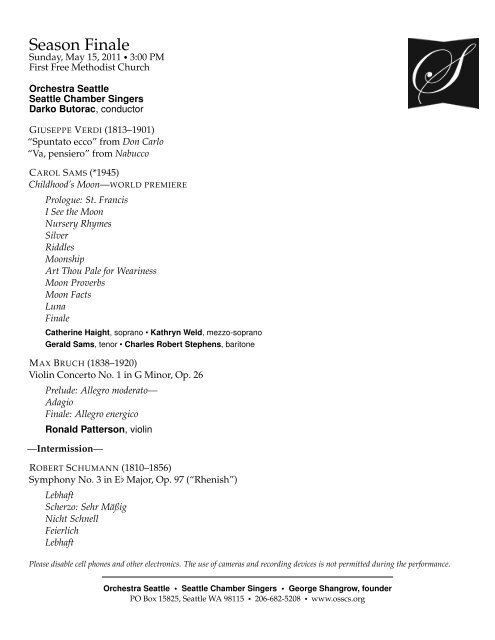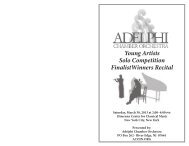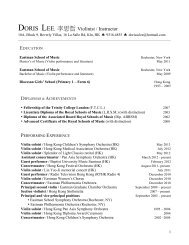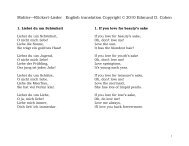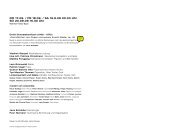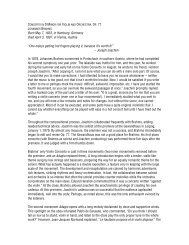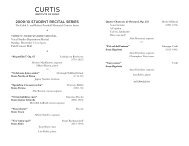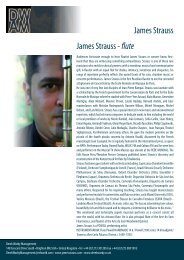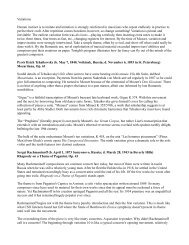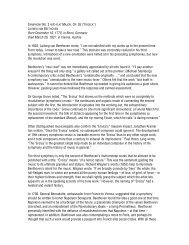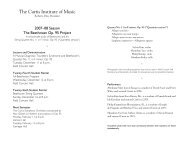Season Finale - InstantEncore
Season Finale - InstantEncore
Season Finale - InstantEncore
You also want an ePaper? Increase the reach of your titles
YUMPU automatically turns print PDFs into web optimized ePapers that Google loves.
<strong>Season</strong> <strong>Finale</strong><br />
Sunday, May 15, 2011 • 3:00 PM<br />
First Free Methodist Church<br />
Orchestra Seattle<br />
Seattle Chamber Singers<br />
Darko Butorac, conductor<br />
GIUSEPPE VERDI (1813–1901)<br />
“Spuntato ecco” from Don Carlo<br />
“Va, pensiero” from Nabucco<br />
CAROL SAMS (*1945)<br />
Childhood’s Moon—WORLD PREMIERE<br />
Prologue: St. Francis<br />
I See the Moon<br />
Nursery Rhymes<br />
Silver<br />
Riddles<br />
Moonship<br />
Art Thou Pale for Weariness<br />
Moon Proverbs<br />
Moon Facts<br />
Luna<br />
<strong>Finale</strong><br />
Catherine Haight, soprano • Kathryn Weld, mezzo-soprano<br />
Gerald Sams, tenor • Charles Robert Stephens, baritone<br />
MAX BRUCH (1838–1920)<br />
Violin Concerto No. 1 in G Minor, Op. 26<br />
Prelude: Allegro moderato—<br />
Adagio<br />
<strong>Finale</strong>: Allegro energico<br />
Ronald Patterson, violin<br />
—Intermission—<br />
ROBERT SCHUMANN (1810–1856)<br />
Symphony No. 3 in E♭ Major, Op. 97 (“Rhenish”)<br />
Lebhaft<br />
Scherzo: Sehr Mäßig<br />
Nicht Schnell<br />
Feierlich<br />
Lebhaft<br />
Please disable cell phones and other electronics. The use of cameras and recording devices is not permitted during the performance.<br />
Orchestra Seattle • Seattle Chamber Singers • George Shangrow, founder<br />
PO Box 15825, Seattle WA 98115 • 206-682-5208 • www.osscs.org
Solo Artists<br />
Guest conductor Darko Butorac serves as music director of<br />
the Missoula Symphony Orchestra and principal conductor<br />
of the Fidenza Opera Festival in Italy. Critics have lauded<br />
his performances as marked by a “great range of expressiveness,”<br />
“extraordinary refinement of dynamic shading”<br />
and a “fine sense of shape and color.” Since taking the helm<br />
of the Missoula Symphony in 2007, Mr. Butorac has propelled<br />
that orchestra to a new level of musical achievement,<br />
with an expanded repertoire and local premieres of works<br />
by established and emerging composers. An enthusiastic<br />
ambassador for classical music, he also produces the awardwinning<br />
Downbeat DownLow podcast with radio personality<br />
Leah Lewis.<br />
Mr. Butorac has appeared as a guest conductor with<br />
such ensembles as the National Arts Centre Orchestra,<br />
Charleston Symphony, Canton Symphony and Montana<br />
Lyric Opera, and served as principal conductor of the Northwest<br />
Mahler Festival. His guest-conducting engagements<br />
abroad include performances with the Trondheim Symphony<br />
in Norway, Mendoza Symphony in Argentina, Xiamen<br />
Philharmonic in China, Kharkov Symphony Orchestra<br />
and Kharkov Philharmonic in Ukraine, and the Giuseppe<br />
Verdi Orchestra of Parma. Engagements this season include<br />
performances with the Belgrade Philharmonic Orchestra as<br />
well as OSSCS.<br />
Darko Butorac earned his Master of Music degree from<br />
Indiana University, where he conducted over 30 concerts<br />
with the school’s major ensembles. He has also worked extensively<br />
at the Brevard Music Center, Aspen Music Festival<br />
and the University of Toronto, his alma mater. His principal<br />
mentors are David Effron, Jorma Panula and David Zinman.<br />
Violinist Ronald Patterson, Professor of Violin at the University<br />
of Washington School of Music since 1999, has concertized<br />
extensively in the United States and Europe since<br />
the age of 11, performing 45 works (including six world<br />
premieres) in more than 150 solo performances with orchestra.<br />
A student of Jascha Heifetz, Eudice Shapiro and<br />
Manuel Compinsky, he has been acclaimed for his “skill,<br />
authority and imagination” by The New York Times. Between<br />
1965 and 1999, Mr. Patterson served as concertmaster of the<br />
Monte Carlo, Houston, Denver and Miami Symphonies, the<br />
St. Louis Little Symphony and the Los Angeles Chamber<br />
Orchestra.<br />
Mr. Patterson was a founder and Associate Professor of<br />
the Shepherd School of Music at Rice University (Houston,<br />
1974–1979) and Assistant Professor at Washington University<br />
(St. Louis, 1967–1971), as well as on the faculty of Stetson<br />
University, MacMurray College and the University of<br />
Miami. He currently serves as first violinist of the Rainier<br />
String Quartet and concertmaster of the New Hampshire<br />
Music Festival Orchestra, the resident quartet of the Santa<br />
Barbara Chamber Music Festival.<br />
Many compositions have been recorded by and written<br />
for Patterson and his wife, violist Roxanna Patteson,<br />
performing as “Duo Patterson.” Czech Mates is their latest<br />
CD, featuring works by 19th and 20th Century Czechoslovakian<br />
composers. Mr. Patterson has also recorded for CRI,<br />
Erato, Orion, Vox, Ante Aeternum, Virgin Classics, Serenus,<br />
Philips and EMI. A five-time First Prize Winner of the Coleman<br />
Chamber Music Competition, he has performed chamber<br />
music with some of the greatest musicians of our day,<br />
including Heifetz, Piatigorsky and Szeryng. In 1998 he was<br />
named Officier de l’Ordre du Mérite Culturel, one of the<br />
Principality of Monaco’s highest honors.<br />
Soprano Catherine Haight is well known to Seattle audiences<br />
for her performances of Baroque music. She is an<br />
accomplished performer of the oratorio repertoire, including<br />
all of the major works of Handel and Bach. Ms. Haight<br />
has been a guest soloist with the Pacific Northwest Ballet in<br />
their acclaimed production of Carmina Burana; her recordings<br />
include Mendelssohn’s Lobgesang with Philharmonia<br />
Northwest, Orff’s Carmina Burana with Seattle Choral Company<br />
and Handel’s Messiah with OSSCS under the direction<br />
of George Shangrow. She is currently a member of the voice<br />
faculty at Seattle Pacific University.<br />
Mezzo-soprano Kathryn Weld has performed extensively<br />
throughout the United States, Canada, Europe and Japan.<br />
She has made solo appearances with the New York Philharmonic<br />
under the direction of Charles Dutoit and Kurt<br />
Masur, and made her Carnegie Hall debut to critical acclaim<br />
in a performance of Bach’s Mass in B Minor.<br />
Tenor Gerald Sams has been a member of the Seattle Chamber<br />
Singers since the early days of the ensemble. With<br />
OSSCS, he has been featured as a soloist in most of the<br />
great Handel oratorios, as well as many Bach cantatas and<br />
works of Mozart. Mr. Sams studied voice at Pomona College<br />
and the University of California at Santa Barbara, and since<br />
that time has sung with many of the choral groups in the<br />
Bay Area and the Pacific Northwest.<br />
Baritone Charles Robert Stephens has performed leading<br />
roles with the New York City Opera and at Carnegie Hall<br />
with the Oratorio Society of New York, the Masterworks<br />
Chorus, Musica Sacra and with Opera Orchestra of New<br />
York. He regularly performs with distinguished ensembles<br />
such as New York’s Sacred Music in a Sacred Space, Seattle<br />
Pro Musica, Portland Chamber Orchestra and Portland<br />
Baroque. This season he debuts with the Oregon Symphony<br />
and Boston Early Music Festival and returns to the Seattle<br />
Symphony and Helena Symphony as well as OSSCS.<br />
✎<br />
✍<br />
OSSCS dedicates this performance to beloved board member Tom Music, who passed away April 17 at age 31. His enthusiasm<br />
for life and music of all kinds inspired us all. We miss him dearly and will always remember his contributions to OSSCS.<br />
☞<br />
✌
Program Notes<br />
Giuseppe Fortunino Francesco Verdi<br />
Choruses from Nabucco and Don Carlo<br />
Verdi was born October 9, 1813, near Busseto, Italy, and died<br />
on January 27, 1901, in Milan. He composed Nabucco in 1840;<br />
it received its premiere on March 9, 1842, at the Teatro alla Scala<br />
in Milan. Don Carlo premiered at the Paris Opera on March 11,<br />
1867, while its revised Italian version was first performed at La<br />
Scala on January 10, 1884.<br />
The son of an innkeeper and a spinner, Giuseppe Verdi<br />
displayed immense musical talent early in life, assisting<br />
as an organist at the local church before assuming the position<br />
on a full-time basis at age nine. His musical fame<br />
rests upon the approximately 30 operas he produced from<br />
1839 through 1893, establishing his reputation as one of the<br />
greatest and most influential of all opera composers.<br />
In 1836, Verdi was appointed municipal music master<br />
in Busseto, where he married his childhood sweetheart.<br />
When Bartolomeo Merelli, impresario at Milan’s illustrious<br />
opera house, La Scala, finally agreed to present Verdi’s<br />
first opera, Oberto, in 1839, it fared well enough for Merelli<br />
to contract with Verdi for several more operas. Personal<br />
tragedy interfered, however: The composer’s daughter had<br />
died in 1838 at the age of 17 months; he then lost his 15-<br />
month-old son just prior to Oberto’s premiere; and within<br />
eight months, his wife suddenly succumbed to encephalitis.<br />
While struggling with these devastating events, Verdi managed<br />
to complete a comic opera, but it proved a miserable<br />
failure. He vowed never to compose again.<br />
Merelli demonstrated a great deal of faith in Verdi, however,<br />
and finally persuaded the composer to examine the<br />
libretto for Nabucco; set in Babylon and Jerusalem in 587 B.C.,<br />
it recounts the biblical story of how King Nebuchadnezzar<br />
attacked the Jews, conquering them and then exiling them<br />
from their homeland. Verdi later recounted, with some dramatic<br />
embellishment, the tale of his arriving home one day,<br />
tossing the libretto on the table, and beginning to read the<br />
passage beginning “Va, pensiero,” the text of the celebrated<br />
chorus in which the enslaved Israelites express their hunger<br />
for their homeland, to which the libretto had fallen open.<br />
The lavish success of Nabucco launched Verdi’s long and<br />
legendary career. He composed the five-act French grand<br />
opera Don Carlo in 1867 but continued to revise it over the<br />
course of some 20 years (its Italian version is most familiar<br />
to today’s audiences). In the midst of the persecutions of<br />
the Inquisition and the Spanish monarchy, Carlos, Prince of<br />
Asturias (1545–1568), struggles with issues of love, loyalty,<br />
friendship, and liberty after his betrothed marries his father,<br />
Philip of Spain, as a provision of the peace treaty ending the<br />
war between the Houses of Habsburg and Valois.<br />
During the final years of his life, the famous and financially<br />
secure composer devoted much of his energy to<br />
the development of his landholdings and to involvement<br />
in charitable activities. He died in 1901 of a massive stroke,<br />
and his funeral was, as he wished, a quiet occasion “without<br />
music or singing.” A month later, tens of thousands<br />
of people lined the streets during his official state funeral<br />
procession and joined in singing the dearly beloved chorus<br />
“Va, pensiero.”<br />
—Lorelette Knowles<br />
Carol Sams<br />
Childhood’s Moon<br />
Carol Sams was born in Sacramento, California, in 1945.<br />
Based on a 2005 work for children’s chorus and piano, this cantata<br />
receives its first performance this afternoon. In addition to SATB<br />
vocal soloists and chorus, it calls for pairs of woodwinds (plus<br />
bass clarinet), 4 horns, 3 trumpets, 3 trombones, percussion, harp<br />
and strings.<br />
Carol Sams is a well-known Seattle composer and soprano.<br />
A student of Darius Milhaud, her works have been<br />
performed by many area ensembles, including OSSCS, and<br />
throughout the United States and Europe. Her full-length<br />
opera The Pied Piper of Hamelin, commissioned by Tacoma<br />
Opera, premiered in 1993. Along with many songs, choral<br />
works and a symphony, Ms. Sams has a total of 12 operas<br />
to her credit. She holds a DMA degree in composition from<br />
the University of Washington, an MA from Mills College,<br />
and is currently music director at Prospect Congregational<br />
Church in Seattle. The composer provided the following<br />
note about her newest work:<br />
Childhood’s Moon is a reworking of an earlier piece,<br />
Songs to the Moon, which I wrote for the Northwest Boychoir<br />
and their ensembles at the request of Joe Crnko, who<br />
performed it in 2005. At the time, I wanted to explore the<br />
relationship of children’s imagination and the moon, specifically<br />
to intrigue children with ideas about the moon through<br />
history, folklore, folksongs, facts and riddles. People have<br />
been fascinated by the moon for so long we even have language<br />
that describes a moony state of mind: loony, moony,<br />
lunatic, moonstruck, moonfaced, moon-eyed, etc. There is<br />
something romantic and crazy and obsessive about our relationship<br />
with the moon, and this was what appealed to me:<br />
taking our complex relationship with the moon and exploring<br />
it. When George Shangrow heard the piece, he thought<br />
it would be good for OSSCS and asked me to orchestrate,<br />
expand and rework it. And so I have done. I have added<br />
a movement, “Moon Proverbs,” and fully orchestrated the<br />
piece, fleshing out the choral parts with tenor and bass, and<br />
expanding the choral parts. Some of the movements have<br />
been transposed in whole or in part. And so it seems to be<br />
a totally new piece; the childlike element is still there, but<br />
almost as from a distance. Certain movements, the riddles<br />
and the nursery rhymes specifically, still have that kind of<br />
innocence, but the other movements have actually changed<br />
character, particularly “Luna,” written to a poem by a talented<br />
young boy. At any rate, I have been charmed by the<br />
moon and these texts, and I hope you will be too.<br />
I want to thank the poets Art Mampel and Morgan<br />
Waidelich for their contributions to this work. Art was kind<br />
enough to tell the St. Francis story in his own words, and to<br />
write the concluding poem.<br />
—Carol Sams
Max Karl August Bruch<br />
Violin Concerto No. 1 in G Minor, Op. 26<br />
Bruch was born in Köln on January 6, 1838, and died near<br />
Berlin on October 2, 1920. Joseph Joachim premiered the revised<br />
version of his first violin concerto in Bremen on January 5, 1868.<br />
In addition to solo violin, the work calls for pairs of woodwinds, 4<br />
horns, 2 trumpets, timpani and strings.<br />
“In my youth, I studied violin for four or five years,”<br />
Max Bruch wrote in 1911, “and although I did not become<br />
an adept performer, I learned to know and love the instrument.<br />
The violin seemed to me even at that time the queen<br />
of instruments, and it was quite natural that I early had<br />
the inclination to write for it. Thus, my first concerto, Op.<br />
26, which was introduced to the musical world by Joachim<br />
during the season of 1867–1868, gradually grew. It was not<br />
at that time my intention, so far as I can remember, to write<br />
further works for the violin; and indeed, for years, I devoted<br />
myself to writing compositions in large form for chorus and<br />
orchestra. In 1873 I wrote Odyssesus and in 1875 Arminius<br />
(which is better known in America than in Germany) and<br />
in 1877 Das Lied von der Glocke.. . . I never had any special<br />
interest for the piano and I wrote only a little for it in my<br />
youth. I was destined by nature to write compositions for<br />
the voice, and I always studied singing with special interest<br />
and have associated largely with singers. This tendency has<br />
also, of course, been displayed in my violin works.”<br />
While Bruch’s Scottish Fantasy for violin and orchestra<br />
and Kol Nidre for cello and orchestra continue to appear on<br />
concert programs, today his fame rests almost exclusively<br />
on the first of his three violin concertos, which stands with<br />
those of Beethoven, Mendelssohn and Brahms among the<br />
greatest masterpieces of the 19th century. The celebrated<br />
Hungarian violinist Joseph Joachim even dubbed Bruch’s<br />
“the richest” and “most seductive” of the four.<br />
The first sketches for Bruch’s concerto date from 1857,<br />
around the time his first opera, Scherz, List und Rache, debuted<br />
in Köln. He completed it in early 1866, with the<br />
premiere slated for April 1, but when the intended soloist<br />
fell ill, violinist Otto von Königslöw stepped in to debut the<br />
concerto at a hastily rescheduled concert on April 24, with<br />
the composer conducting. Bruch subsequently withdrew<br />
the work to make revisions, sending the new manuscript<br />
to Joachim the following summer. Joachim provided helpful<br />
suggestions and participated in a private rehearsal at<br />
Hanover in October 1867. Bruch dedicated the concerto to<br />
Joachim, who performed the official premiere of the revised<br />
version the following January.<br />
Although cast in the standard three movements, Bruch<br />
originally labeled the opening Introduzione, quasi fantasia before<br />
settling on the title Vorspiel (“Prelude”). It leads without<br />
pause to the central Adagio, in which three distinct musical<br />
motives unfold in turn, most clearly demonstrating the linkage<br />
between Bruch’s vocal compositions and his writing for<br />
solo violin. The Gypsy-dance finale, marked Allegro energico,<br />
predates the similarly themed closing movement of Brahms’<br />
violin concerto by nearly a decade.<br />
Over the course of his long life, Bruch developed something<br />
of a love-hate relationship with this concerto. This may<br />
have been due in part to the fact that he sold the publishing<br />
rights to the work for a one-time fee and never saw any<br />
royalties from his first and greatest musical success. Late<br />
in life, after World War I left him in dire financial straits, he<br />
attempted to sell his autograph copy in the United States,<br />
but never received any payment prior to his death in 1920.<br />
Robert Schumann<br />
Symphony No. 3 in E♭ Major, Op. 97 (“Rhenish”)<br />
Schumann was born in Zwickau, Saxony, on June 8, 1810,<br />
and died near Bonn on July 29, 1856. He composed this symphony<br />
between November 2 and December 9, 1850. Schumann<br />
himself conducted the premiere in Düsseldorf on February 6 of the<br />
following year. The work calls for pairs of woodwinds, 4 horns, 2<br />
trumpets, 3 trombones, timpani and strings.<br />
Robert Schumann’s tenure as municipal music director<br />
at Düsseldorf, along the banks of the Rhine, would end<br />
badly: After averting a forced resignation in October 1852,<br />
he would step down the following year and in February<br />
1854 attempted suicide by jumping off a bridge into the<br />
Rhine. He would spend the remaining two years of his life<br />
in an insane asylum near Bonn.<br />
But Schumann’s arrival in Düsseldorf with his wife<br />
Clara, on September 2, 1850, marked a time of great optimism<br />
for the composer, sparking a period of inspired<br />
composition. He produced his remarkable cello concerto<br />
in a mere 15 days during October, and at the beginning<br />
of November began work on the last and greatest of his<br />
four symphonies (the so-called Symphony No. 4, published<br />
last, being a revision of a work first performed in 1841).<br />
“Robert is at work on something,” Clara wrote in her diary<br />
on November 16, “I do not know what, for he has said nothing<br />
to me about it.” Schumann completed the symphony<br />
in just over a month, presenting it to his wife as a surprise<br />
on December 9. He conducted the premiere the following<br />
February at Düsseldorf’s Geisler Hall on the sixth concert<br />
of the Allgemeine Musikverein. On March 19, 1851, the<br />
composer wrote to a publisher that his new work “perhaps<br />
mirrors here and there something of Rhenish life.”<br />
Schumann cast his symphony in five movements instead<br />
of the traditional four, although the majestic fourth<br />
movement can be viewed as grand slow introduction to<br />
the finale. The heroic theme of the opening movement, announced<br />
by horns, is one of Schumann’s most magnificent<br />
creations, its ingenious cross-rhythms obscuring the pulse<br />
of the 3 4<br />
meter until the seventh bar. Instead of the typical<br />
scherzo, Schumann follows with a ländler, a more deliberate<br />
dance form in 3 4<br />
time; at one point he appears to have subtitled<br />
the movement “Morning on the Rhine” but deleted all<br />
programmatic notations from the score before publication.<br />
Next comes a graceful intermezzo in place of the traditional<br />
slow movement.<br />
The fourth movement originally bore the subtitle, “In<br />
the character of the accompaniment to a solemn ceremony.”<br />
During November 1850, the Schumanns had traveled to<br />
Köln for a ceremony elevating the local archbishop to a car-
dinal. The event took place at the city’s imposing Gothic<br />
cathedral. Construction of the edifice began in 1248, continuing<br />
until 1473, when work halted until 1842. Schumann had<br />
first seen the cathedral in 1830, and even in its unfinished<br />
state it dominated the skyline. After its completion in 1880,<br />
it was the tallest building in the world—until the Washington<br />
Monument was finished in 1884. Schumann introduces<br />
three trombones at the opening of the fourth movement to<br />
help create an aura of religious solemnity.<br />
The joyful finale bears hallmarks of a rondo form, with<br />
Schumann unleashing a succession of new themes eventually<br />
joined—somewhat unexpectedly—by music from<br />
the slow movement now in celebratory rather than solemn<br />
guise. A brief coda recalls the spirit of the opening movement.<br />
—Jeff Eldridge<br />
✓<br />
✒<br />
Please visit www.osscs.org to sign up for our mailing list, follow us on Facebook and Twitter,<br />
and learn details about the exciting 2011–2012 OSSCS season, details of which will be announced soon.<br />
✏<br />
✑<br />
Orchestra Seattle<br />
Violin<br />
Susan Beals<br />
Lauren Daugherty<br />
Dean Drescher<br />
Stephen Hegg<br />
Susan Herring<br />
Jason Hershey<br />
Manchung Ho<br />
Emmy Hoech<br />
Fritz Klein**<br />
Pam Kummert<br />
Jim Lurie<br />
Mark Lutz<br />
Susan Ovens<br />
Stephen Provine*<br />
Theo Schaad<br />
Janet Showalter<br />
Kenna Smith-Shangrow<br />
Nicole Tsong<br />
Viola<br />
Deborah Daoust<br />
Audrey Don<br />
Katherine McWilliams*<br />
Genevieve Schaad<br />
Robert Shangrow<br />
Alexandra Takasugi<br />
Karoline Vass<br />
Kailee Wright<br />
Cello<br />
Kaia Chessen<br />
Peter Ellis<br />
Patricia Lyon<br />
Katie Sauter Messick<br />
Douglas Aaron Nation<br />
Valerie Ross<br />
Morgan Shannon<br />
Matthew Wyant*<br />
Bass<br />
Jo Hansen*<br />
Ericka Kendall<br />
Nick Masters<br />
Kevin McCarthy<br />
Steven Messick<br />
Flute<br />
Jenna Calixto<br />
Shari Muller-Ho*<br />
Piccolo<br />
Melissa Underhill<br />
Oboe<br />
David Barnes*<br />
John Dimond<br />
Clarinet<br />
Alan Lawrence<br />
Steven Noffsinger*<br />
Bass Clarinet<br />
Cynthia Ely<br />
Bassoon<br />
Jeff Eldridge<br />
Judith Lawrence*<br />
Horn<br />
Barney Blough<br />
Don Crevie<br />
Jaime Faucher<br />
Laurie Heidt<br />
Jim Hendrickson<br />
Trumpet<br />
Nathan Callaghan<br />
Gary Roberts<br />
Delsin Thomas<br />
Janet Young*<br />
Trombone<br />
Paul Bogotaj<br />
Moc Escobedo*<br />
David Holmes<br />
Tuba<br />
David Brewer<br />
Percussion<br />
Kathie Flood<br />
Dan Oie*<br />
Harp<br />
Bethany Man<br />
** concertmaster<br />
** principal<br />
Soprano<br />
Barb Anderson<br />
Crissa Cugini<br />
Cinda Freece<br />
Anne Grosse-Wilde<br />
Kiki Hood<br />
Achil Jackson<br />
Jill Kraakmo<br />
Peggy Kurtz<br />
Lila Woodruff May<br />
Nancy Shasteen<br />
Melissa Thirloway<br />
Liesel van Cleeff<br />
Alto<br />
Sharon Agnew<br />
Jane Blackwell<br />
Suzanne Fry<br />
Rose Fujinaka<br />
Pamela Ivezič<br />
Ellen Kaisse<br />
Jan Kinney<br />
Lorelette Knowles<br />
Theodora Letz<br />
Laurie Medill<br />
Julia Akoury Thiel<br />
Annie Thompson<br />
Tenor<br />
Ron Carson<br />
Jon Lange<br />
Tom Nesbitt<br />
Victor Royer<br />
Jerry Sams<br />
Seattle Chamber Singers<br />
Bass<br />
Andrew Danilchik<br />
Stephen Keeler<br />
Jeff Thirloway<br />
Slosson Viau<br />
Richard Wyckoff
Vocal Texts and Translations<br />
Don Carlo<br />
POPULACE<br />
Spuntato ecco il dì d’esultanza,<br />
Onore al più grande dei Regi!<br />
In esso hanno i popol’ fidanza,<br />
Il mondo è prostrato al suo piè!<br />
Il nostro amor ovunque l’accompagna,<br />
E questo amor giammai non scemerà.<br />
Il nome suo è l’orgoglio della Spagna,<br />
E viver deve nell’eternità!<br />
MONKS<br />
ll dì spuntò, dì del terrore,<br />
Il dì tremendo, il dì feral.<br />
Morran, morran! Giusto è il rigore dell’Immortal.<br />
Ma di perdón voce suprema<br />
All’anatema—succederà,<br />
Se il peccator all’ora estrema<br />
Si pentirà!<br />
POPULACE<br />
Spuntato è il di. . .<br />
D’esultanza, onor al Re!<br />
In esso hanno i popol’fidanza,<br />
Il mondo è prostrato al suo piè!<br />
Ei vivra nell’eternità!<br />
Onor al Re! Onor al Re!<br />
Nabucco<br />
HEBREWS<br />
Va, pensiero, sull’ali dorate.<br />
Va, ti posa sui clivi, sui colli,<br />
Ove olezzano tepide e molli<br />
L’aure dolci del suolo natal!<br />
Del Giordano le rive saluta,<br />
Di Sionne le torri atterrate.<br />
O mia Patria sì bella e perduta!<br />
O membranza sì cara e fatal!<br />
Arpa d’or dei fatidici vati,<br />
Perché muta dal salice pendi?<br />
Le memorie nel petto raccendi,<br />
Ci favella del tempo che fu!<br />
O simile di Sólima ai fati,<br />
Traggi un suono di crudo lamento;<br />
O t’ispiri il Signore un concento<br />
Che ne infonda al patire virtù.<br />
Childhood’s Moon<br />
There is a magical story about St. Francis<br />
Enjoying the night air one evening in the village of Assisi.<br />
When the moon came up, it was huge and luminous,<br />
Bathing the entire earth in its radiance.<br />
Noticing that no one else was outside to enjoy this miracle,<br />
Francis ran to the bell tower and began<br />
ringing enthusiastically.<br />
The joyous day at last hath dawned,<br />
Honor to our most mighty King;<br />
Implicit trust his people place in him,<br />
The world is prostate at his feet!<br />
Our love will everywhere attend him,<br />
No, never shall that love decrease,<br />
His bright name is the pride of Spain,<br />
His fame will through the ages live!<br />
The day hath dawned, the day of terror!<br />
The tremendous day, the funeral day.<br />
They shall die, they shall die,<br />
Just is the punishment of the Immortal!<br />
But pardon will e’en malediction follow,<br />
If the unhappy sinner but repent<br />
At the last hour!<br />
The joyous day hath dawned. . .<br />
All honor to our King!<br />
All faith in him his subjects have,<br />
The world lies prostate at his feet!<br />
He will live in eternity!<br />
Honor to the King!<br />
Fly, thought, on wings of gold.<br />
Go settle upon the slopes and the hills,<br />
Where, soft and mild, the sweet airs<br />
Of our native land smell fragrant!<br />
Greet the banks of the Jordan<br />
And Zion’s toppled towers.<br />
Oh, my country so beautiful and lost!<br />
Oh, remembrance so dear and so fatal!<br />
Golden harp of the prophetic seers,<br />
Why dost thou hang mute upon the willow?<br />
Rekindle our bosom’s memories,<br />
And speak to us of times gone by!<br />
Mindful of the fate of Jerusalem,<br />
Give forth a sound of crude lamentation,<br />
Or may the Lord inspire you a harmony of voices<br />
Which may instill virtue to suffering.<br />
When the people came out of the houses, in alarm, and<br />
Saw Francis at the top of the tower,<br />
they called up to ask of him an explanation.<br />
Francis simply replied, “Lift up your eyes, my friends,<br />
Look at the moon!”<br />
—as told by Arthur Mampel
I see the moon, the moon sees me,<br />
God bless the moon and God bless me,<br />
When I see the moon and stars so bright,<br />
I thank the Lord for each day and night.<br />
—traditional<br />
The man in the moon came down too soon,<br />
And asked the way to Norwich,<br />
He went by the south and burned his mouth<br />
Eating cold pease porridge.<br />
Hey diddle diddle, the cat and the fiddle,<br />
The cow jumped over the moon.<br />
The little dog laughed to see such a sight,<br />
And the dish ran away with the spoon.<br />
There were three jolly Welshmen, as I have heard them say,<br />
And they would go a hunting, upon St. David’s day.<br />
All the day they hunted and nothing<br />
could they find but a ship<br />
A-sailing, with the wind.<br />
One said it was a ship, the other he said, nay:<br />
The third one said it was a house,<br />
and the chimney blown away.<br />
And all the night they hunted and nothing could they find,<br />
But the moon a-gliding, a-gliding with the wind.<br />
Sally go round the sun,<br />
Sally go round the moon,<br />
Sally go round the chimney pots<br />
On a Saturday afternoon.<br />
—collected nursery rhymes<br />
Slowly, silently, now the moon<br />
Walks the night in her silver shoon;<br />
This way, and that, she peers, and sees<br />
Silver fruit upon silver trees;<br />
One by one the casements catch<br />
Her beams beneath the silvery thatch;<br />
Couched in his kennel, like a log,<br />
With paws of silver sleeps the dog;<br />
From their shadowy cote the white breasts peep<br />
Of doves in silver feathered sleep<br />
A harvest mouse goes scampering by,<br />
With silver claws, and silver eye;<br />
And moveless fish in the water gleam,<br />
By silver reeds in a silver stream.<br />
—Walter de la Mare<br />
Q: What kind of ticks do you find on the moon?<br />
A: Lunaticks.<br />
Q: What did the moon man cook for lunch?<br />
A: An unidentified frying object.<br />
Q: What kind of bulbs should you plant on the moon?<br />
A: Light bulbs.<br />
Q: And why can’t the astronauts land on the moon?<br />
A: It was already full.<br />
Q: What holds the moon up?<br />
A: Moonbeams!<br />
—collected riddles<br />
In the ocean of the sky borne on rising waves of cloud,<br />
The moonship goes gilding by<br />
Through a forest of stars.<br />
—from the Japanese<br />
Art thou pale for weariness<br />
Of climbing heaven and gazing on the earth,<br />
Wandering companionless<br />
Among the stars that have a different birth,<br />
And ever changing, like a joyless eye<br />
That finds no object worth its constancy?<br />
—Percy Bysshe Shelley<br />
#1. What does the moon care if the dogs bark at her?<br />
#2. Look in the sky to find the moon, not in the pond.<br />
#3. If thou piercest thy foot with a thorn, burn thou the thorn<br />
#3. in the light of a new moon, lest the devil possess thy foot.<br />
#4. If you cry because you miss the sun,<br />
#4. your tears will not let you see the moon.<br />
#5. When the moon is pale, it will rain.<br />
#5. When the moon is red, it will be windy.<br />
#5. But when the moon is clear, it will be serene.<br />
#6. No matter how fast moonlight runs,<br />
#6. daylight always catches up.<br />
—collected proverbs<br />
Luna!<br />
The moon is the second brightest object in the sky after the sun.<br />
The moon is 225,745 miles away.<br />
Daytime temperature is 273 degrees Fahrenheit,<br />
While nighttime temperature is a minus 245!<br />
Twelve men have walked upon the moon.<br />
The moon has 9.4 billion acres.<br />
It weighs 81 quintillion tons.<br />
And the moon is not round at all, it is shaped like an egg;<br />
The large end is pointed toward us.<br />
—collected facts<br />
Luna, Moon alone, gray, melancholy,<br />
Sees millions of stars and planets light years away.<br />
I remember when first space shuttle<br />
landing on my glassy face,<br />
So alone, so sad.<br />
Orbiting the one friend that seldomly speaks.<br />
—Morgan Waidelich<br />
Splendidly you rise across this field of gold,<br />
Gracing the land in light,<br />
Gracing the earth with radiance.<br />
On this October evening,<br />
The facial flush of your rising<br />
Awakens a hope strange and wonderful,<br />
To soften a human heart<br />
You sit, on that distant hill,<br />
Like a generous mother,<br />
Granting to her children the luminous warmth<br />
Of your wide, silver embrace.<br />
—Arthur Mampel


